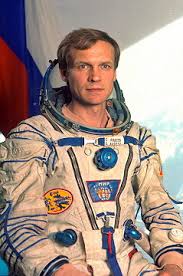Sergei Avdeyev
Russian - (RFSA)
Retired
Date of Birth: Jan. 1, 1956
Age: 70
Sergei Vasilyevich Avdeyev (Сергей Васильеви Авдеев; born 1 January 1956) is a Russian engineer and cosmonaut. Avdeyev was born in Chapayevsk, Samara Oblast (formerly Kuybyshev Oblast), Russian SFSR. He graduated from Moscow Physics-Engineering Institute in 1979 as an engineer-physicist. From 1979 to 1987 he worked as an engineer for NPO Energiya. He was selected as a cosmonaut as part of the Energia Engineer Group 9 on 26 March 1987. His basic cosmonaut training was from December 1987 through to July 1989. He retired as a cosmonaut on 14 February 2003. Avdeyev at one point held the record for cumulative time spent in space with 747.59 days in earth orbit, accumulated through three tours of duty aboard the Mir Space Station. He has orbited the earth 11,968 times traveling about 515,000,000 kilometers.
Soyuz-U2 | Soyuz TM-15
Soviet Space Program | RussiaBaikonur Cosmodrome, Republic of Kazakhstan
July 27, 1992, 6:08 a.m.
Status: Success
Mission:
Soyuz TM-15 was the 15th mission and the 12th long-duration expedition to Mir space station. The mission began on July 27, 1992, 06:08:42 UTC, launching Commander Anatoly Solovyev, Flight Engineer Sergei Avdeyev and Research Cosmonaut Michel Tognini into orbit. They docked with Mir two days later. During their stay there, cosmonauts performed EVAs, various station repair and maintenance tasks, and carried out scientific experiments in materials research, space technology, astrophysics and earth observation. They were visited by several Progress resupply spacecrafts, and welcomed aboard the Soyuz TM-16 crew. The mission concluded with a safe landing back on Earth on February 1, 1993, 03:49:57 UTC.
Low Earth OrbitSoyuz-U2 | Soyuz TM-22
Soviet Space Program | RussiaBaikonur Cosmodrome, Republic of Kazakhstan
Sept. 3, 1995, 9 a.m.
Status: Success
Mission:
Soyuz TM-22 was the 23rd mission and the 20th long-duration expedition to Mir space station. It was also a part of the US/Russian Shuttle-Mir Program. The mission began on September 3, 1995, 09:00:23 UTC, launching Commander Yuri Gidzenko, Flight Engineer Sergei Avdeyev and Research Cosmonaut Thomas Reiter into orbit. They docked with Mir two days later. During their stay there, cosmonauts performed several EVAs and various scientific experiments. Station crew was visited by several Progress resupply spacecrafts, STS-74, and welcomed aboard Soyuz TM-23 with the next expedition crew. The mission concluded with a safe landing back on Earth on February 29, 1996, 10:42:08 UTC.
Low Earth OrbitSoyuz-U | Soyuz TM-28
Russian Federal Space Agency (ROSCOSMOS) | RussiaBaikonur Cosmodrome, Republic of Kazakhstan
Aug. 13, 1998, 9:43 a.m.
Status: Success
Mission:
Soyuz TM-28 was the 37th mission and the 26th long-duration expedition to Mir space station. The mission began on August 13, 1998, 09:43:11 UTC, launching Commander Gennady Padalka, Flight Engineer Sergei Avdeyev and Research Cosmonaut Yuri Baturin into orbit. They docked with Mir two days later. During their stay there, cosmonauts performed several EVAs and various scientific experiments in medicine, biotechnology, Earth sciences etc. Station crew was visited by several Progress resupply spacecrafts, and welcomed aboard Soyuz TM-29 with the next expedition crew. The mission concluded with a safe landing back on Earth on February 28, 1999, 02:14:30 UTC.
Low Earth OrbitSoyuz-U | Soyuz TM-29
Russian Federal Space Agency (ROSCOSMOS) | RussiaBaikonur Cosmodrome, Republic of Kazakhstan
Feb. 20, 1999, 4:18 a.m.
Status: Success
Mission:
Soyuz TM-29 was the 38th mission and the 27th long-duration expedition to Mir space station. The mission began on February 20, 1999, 04:18:01 UTC, launching Commander Viktor Afanasyev, Flight Engineer Jean-Pierre Haigneré and Research Cosmonaut/Fight Engineer Ivan Bella, who became the first Slovakian cosmonaut, into orbit. They docked with Mir two days later. During their stay there, cosmonauts performed several EVAs and various scientific experiments. Station crew was visited by several Progress resupply spacecrafts. The mission concluded with a safe landing back on Earth on August 28, 1999, 00:34:20 UTC.
Low Earth OrbitThe Roscosmos State Corporation for Space Activities, commonly known as Roscosmos, is the governmental body responsible for the space science program of the Russian Federation and general aerospace research. Soyuz has many launch locations the Russian sites are Baikonur, Plesetsk and Vostochny however Ariane also purchases the vehicle and launches it from French Guiana.
Long March 12
SatNet LEO Group 19
Commercial LC-2 - Wenchang Space Launch Site, People's Republic of ChinaA batch of 9 Low Earth Orbit communication satellites for the Chinese state owned SatNet constellation operated by the China Satellite Network Group.…
Falcon 9
Starlink Group 6-100
Space Launch Complex 40 - Cape Canaveral SFS, FL, USAA batch of 29 satellites for the Starlink mega-constellation - SpaceX's project for space-based Internet communication system.
Falcon 9
NROL-105
Space Launch Complex 4E - Vandenberg SFB, CA, USATwelfth batch of satellites for a reconnaissance satellite constellation built by SpaceX and Northrop Grumman for the National Reconnaissance Office …
Ceres-2
Demo Flight
Launch Area 95A - Jiuquan Satellite Launch Center, People's Republic of ChinaFirst test launch of Galactic Energy’s Ceres-2 rocket.
Long March 3B/E
Shijian 32
Launch Complex 2 (LC-2) - Xichang Satellite Launch Center, People's Republic of ChinaChinese experimental spacecraft of unknown purposes.




